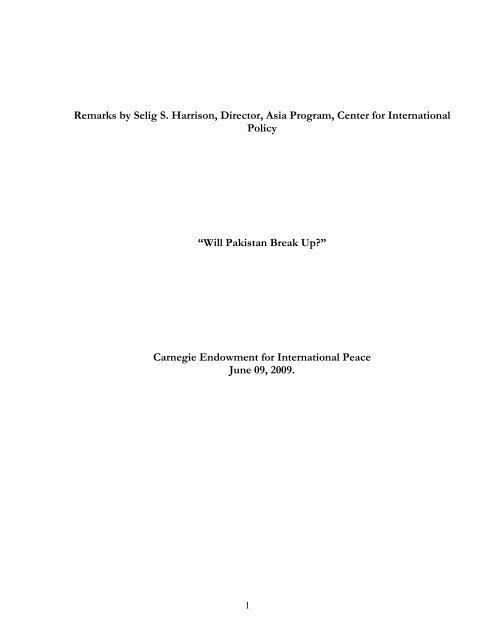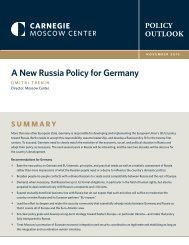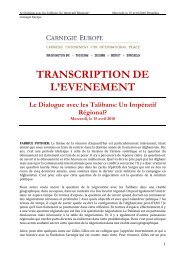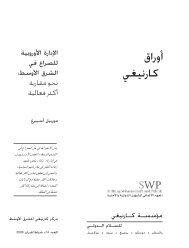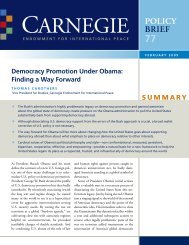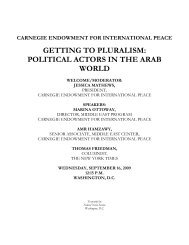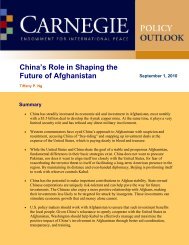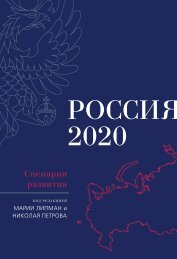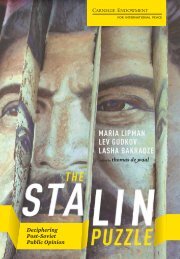Will Pakistan Break Up? - Carnegie Endowment for International ...
Will Pakistan Break Up? - Carnegie Endowment for International ...
Will Pakistan Break Up? - Carnegie Endowment for International ...
You also want an ePaper? Increase the reach of your titles
YUMPU automatically turns print PDFs into web optimized ePapers that Google loves.
Remarks by Selig S. Harrison, Director, Asia Program, Center <strong>for</strong> <strong>International</strong><br />
Policy<br />
“<strong>Will</strong> <strong>Pakistan</strong> <strong>Break</strong> <strong>Up</strong>?”<br />
<strong>Carnegie</strong> <strong>Endowment</strong> <strong>for</strong> <strong>International</strong> Peace<br />
June 09, 2009.<br />
1
Remarks Not Checked Against Delivery<br />
I’m going to start with a citation from the Scripture. Scripture <strong>for</strong> me on the subject<br />
of <strong>Pakistan</strong> is an important book called The Shadow of the Great Game: The Untold Story of India’s<br />
Partition, by Narendra Singh Sarila, a retired Indian diplomat who was the ADC to<br />
Mountbatten. He got unprecedented access to the British archives. In his book he presents<br />
detailed, definitive evidence showing that as early as March, 1945, Winston Churchill and the<br />
British General Staff decided that Partition was necessary <strong>for</strong> strategic reasons. They<br />
deliberately set out to create <strong>Pakistan</strong> because Jinnah had promised to provide military<br />
facilities and Nehru refused to do so.<br />
This is the key to understanding why <strong>Pakistan</strong> is so dysfunctional. It’s an artificial<br />
political entity. The British put together five ethnic groups that had never be<strong>for</strong>e co-existed<br />
in the same body politic historically. The Bengalis were the biggest. They outnumbered all<br />
of the other four combined—the Punjabis, the Pashtuns, the Baluch and the Sindhis. Five<br />
became four of course when Bangladesh seceded.<br />
As it happened I was in Dacca during the Bangladesh crisis of 1971 when the Army<br />
moved in to crush the independence movement. I had a memorable conversation with<br />
Zulfiqar Ali Bhutto in which he said it would be best if the Bengalis did secede because<br />
<strong>Pakistan</strong> would be more manageable without them. What he meant was that he would have<br />
a better chance of running <strong>Pakistan</strong> in cooperation with the Punjabis if he could get rid of<br />
the Bengalis. And that’s what happened except that the Army, as you know, eventually<br />
executed him.<br />
The Army bequeathed by the British to <strong>Pakistan</strong> was overwhelmingly dominated by<br />
Punjabi officers and soldiers. So with the Bengalis gone the Baluch, Pashtuns and Sindhis<br />
have faced a cruel historical irony. For centuries they had resisted the incursions of the<br />
2
Remarks Not Checked Against Delivery<br />
Moghuls into their territories, but now they find themselves ruled by Punjabis who invoke<br />
the grandeur of the Moghuls to justify their power. Together the three ethnic minorities<br />
constitute only 33 percent of the population, but they consider 72 percent of <strong>Pakistan</strong><br />
territory to be their ancestral homelands. That is a prescription <strong>for</strong> built-in conflict.<br />
Let’s look at the Baluch first because they have an active insurrection going. They<br />
never wanted to be in <strong>Pakistan</strong>. They had to be <strong>for</strong>cibly incorporated in 1958 by a <strong>Pakistan</strong><br />
occupation Army. The army still has cantonments located all over Baluchistan to cope with<br />
an insurgency that is periodically suppressed and then soon revives. The insurgency is fueled<br />
primarily by Baluch resentment of the Punjabi economic exploitation of Baluchistan,<br />
especially the extraction of most of the natural gas used by the rest of <strong>Pakistan</strong> on what the<br />
Baluch consider unfair terms. Baluchistan has enormous natural resources including oil that<br />
can’t be developed until the insurgency ends. There are 22 <strong>for</strong>eign investment projects in<br />
Baluchistan now on hold so this is a big debilitating economic problem <strong>for</strong> <strong>Pakistan</strong> in<br />
addition to a political and military problem.<br />
The Army and its intelligence agencies do their best to divide the Baluch by buying<br />
off and assassinating their leaders. They have killed two strong leaders of the Baluch<br />
insurgent <strong>for</strong>ces in recent years, first Akbar Bugti and more recently Balach Marri, making<br />
them martyrs. At the moment the Baluch armed struggle does not have effective united<br />
leadership but the six million Baluch are politically more aroused than ever be<strong>for</strong>e. There<br />
are still some moderate Baluch political figures who favor staying in <strong>Pakistan</strong> if the<br />
minorities get the provincial autonomy envisaged in the 1973 Constitution, but support <strong>for</strong><br />
independence is growing. The ISI continues to round up Baluch and Sindhis without giving<br />
them access to lawyers and courts despite the advent of the so-called civilian government in<br />
3
Remarks Not Checked Against Delivery<br />
Islamabad. More than 900 Baluch and Sindhi activists have disappeared without a trace. I<br />
urge you to read the Amnesty <strong>International</strong> report, Denying the Undeniable: En<strong>for</strong>ced<br />
Disappearances in <strong>Pakistan</strong>, which cites chapter and verse on this massive violation of human<br />
rights, more than the much publicized disappearances in Pinochet’s Chile.<br />
By themselves, the Baluch are in a weak position militarily, but they are beginning to<br />
<strong>for</strong>ge alliances with Sindhi factions that could become significant. What the Baluch and<br />
Sindhi leaders are talking about is a sovereign Baluch-Sindhi federation stretching from the<br />
Indian border to Iran. The most obvious impediment to this dream of course is the fact that<br />
Karachi is right in the middle of the area concerned with a multi-ethnic population. But the<br />
Baluch and Sindhis point out that Karachi depends on gas and water pipelines crossing<br />
through areas of the surrounding countryside under their control.<br />
In my report I conclude that the future of Sind and Baluchistan will depend on how<br />
relations between India and <strong>Pakistan</strong> evolve. Until now there has been a consensus in India<br />
that a stable <strong>Pakistan</strong> is in the Indian interest. But <strong>Pakistan</strong>’s failure to act against Lashkar-e-<br />
Taiba since the Mumbai attacks has led to some re-thinking.<br />
As Indian anger grows, so does the view that India should support Baluch and<br />
Sindhi separatism, either as an alternative to full-scale military retaliation against <strong>Pakistan</strong> or<br />
as a key part of a two-front military strategy. As an alternative, stirring up the Baluch and<br />
Sindhis would avoid the risks of a direct military encounter with <strong>Pakistan</strong> that could escalate<br />
to the nuclear level and lead to an exodus of <strong>for</strong>eign investment. As part of a two-front<br />
strategy, Indian support <strong>for</strong> Baluch and Sindhi insurgents would keep substantial <strong>Pakistan</strong>i<br />
<strong>for</strong>ces tied down on the long Sind frontier while others face Indian <strong>for</strong>ces in Kashmir, or the<br />
Punjab, or both.<br />
4
Remarks Not Checked Against Delivery<br />
For the past five years, <strong>Pakistan</strong> has accused India of aiding Baluch insurgent groups through<br />
its consulates in Afghanistan but has not provided supporting evidence. These charges have<br />
lacked credibility because the Baluch have fought with ineffectual small arms. The Baluch<br />
say their weaponry has been purchased on the black market, with funding from Baluch<br />
compatriots in Dubai and other Persian Gulf states. Should India in fact decide to give the<br />
Baluch large-scale sophisticated weaponry, logistical help and funds, they could rapidly<br />
expand their present <strong>for</strong>ce of 4,500 fighters, drawing on the large numbers of Baluch<br />
unemployed.<br />
At present, the prospects <strong>for</strong> an independent Baluchistan, or a Baluch-Sind<br />
federation, appear remote. But the game-changer would be a war between India and<br />
<strong>Pakistan</strong> in which the Indian air <strong>for</strong>ce directly supports Baluch insurgent <strong>for</strong>ces. In past<br />
battles with the Baluch the <strong>Pakistan</strong> air <strong>for</strong>ce has bombed Baluch insurgents and civilians<br />
alike ruthlessly and the Baluch would need Indian air cover to take and hold territory.<br />
In addition to their enormous firepower, the <strong>Pakistan</strong> armed <strong>for</strong>ces control a wide-<br />
ranging business empire with assets of $38 billion that gives them the economic staying<br />
power needed to sustain a protracted struggle.<br />
Whether or not tensions with India lead to the breakup of <strong>Pakistan</strong>, Baluch and<br />
Sindhi separatist groups are likely to increase their paramilitary capabilities in the years ahead.<br />
Thus, unless the central government pursues a peaceful accommodation with the minority<br />
provinces, <strong>Pakistan</strong>’s already-serious economic problems will be intensified by debilitating<br />
ethnic tensions. These tensions will hinder economic development and make the<br />
implementation of <strong>for</strong>eign investment agreements impossible in large sections of the<br />
country. In my report I discuss in detail what is necessary <strong>for</strong> a peaceful accommodation,<br />
5
Remarks Not Checked Against Delivery<br />
especially implementation of the 1973 Constitution leading to a meaningful devolution of<br />
power to the provinces.<br />
Now, turning to the Pashtuns, it is necessary to bear in mind that the 41 million<br />
Pashtuns on both sides of the border have a long history of unity.<br />
Prior to the British Raj, the Pashtuns had been politically unified since 1747 under<br />
the banner of an Afghan empire that stretched eastward into the Punjabi heartland up to the<br />
Indus River. It was traumatic <strong>for</strong> them when the British seized 40,000 square miles of<br />
ancestral Pashtun territory between the Indus and the Khyber Pass, embracing half the<br />
Pashtun population, and then imposed the Durand Line, <strong>for</strong>malizing their conquest. The<br />
British subsequently handed over this territory to the new government of <strong>Pakistan</strong> in 1947<br />
after a controversial 1947 referendum in the Northwest Frontier Province. The referendum<br />
was administered under the control of British colonial authorities who openly favored the<br />
accession of the province to <strong>Pakistan</strong>. Out of 572,799 eligible voters, only 292,118 voted.<br />
This was because the referendum was boycotted by many Pashtuns. The Pashtun parties<br />
that had overwhelmingly won the 1946 provincial elections wanted the referendum to<br />
include the option of an independent “Pashtunistan” in addition to a choice between India<br />
and <strong>Pakistan</strong>. The leaders of these parties were imprisoned prior to the referendum and<br />
their newspapers banned after their “Bannu Declaration” calling <strong>for</strong> “Pashtunistan” on June<br />
22, 1947. Out of those Pashtuns who did vote in tribal gatherings convened by the British<br />
authorities, all but 2,894 voted <strong>for</strong> <strong>Pakistan</strong>. Thus the issue was decided by 50.5 percent of<br />
the eligible electorate amid charges of blatant rigging that still resonate today.<br />
After the creation of <strong>Pakistan</strong>, Zahir Shah’s monarchy, Mohammed Daud’s republic<br />
and the short-lived Communist regime in Kabul have all challenged <strong>Pakistan</strong>’s right to rule<br />
6
Remarks Not Checked Against Delivery<br />
over its Pashtun areas. At times Afghanistan has espoused the goal of an autonomous<br />
Pashtun state to be created within <strong>Pakistan</strong>, at times an independent “Pashtunistan” to be<br />
carved out of <strong>Pakistan</strong> and at times a “Greater Afghanistan” that directly annexes the lost<br />
territories.<br />
The resistance movement against the Soviet occupation and the U.S. offensive<br />
against Al Qaeda and the Taliban that began in 2001 have produced deep divisions in<br />
Pashtun society that make the future of the Pashtunistan” movement uncertain. The<br />
traditional supremacy of the malik over the mullah in tribal society was weakened when the<br />
United States, together with Islamist groups in Saudi Arabia and the Persian Gulf, channeled<br />
weapons aid and funding <strong>for</strong> the anti-Soviet struggle to favored Islamist clients in<br />
Afghanistan. This was at the behest of the <strong>Pakistan</strong> Directorate of Inter-Services<br />
Intelligence. The ISI’s objective was to build up surrogates opposed to the Pashtunistan<br />
concept. When these surrogates proved unable to consolidate their power after Soviet <strong>for</strong>ces<br />
left, the ISI turned to the Taliban, which had a Pashtun base but was dominated by clerical<br />
leaders with a pan-Islamist ideology. Significantly, however, the Taliban government that<br />
ruled from 1996 to 2001 did not accept the Durand Line despite <strong>Pakistan</strong>i pressure to do so.<br />
Notwithstanding the divisions in Pashtun society produced by the convulsions of the<br />
past three decades and the resulting growth in the power of the mullah at the expense of the<br />
malik, the Pashtuns continue to have a powerful sense of collective identity rooted in an<br />
ancient tribal structure that still defines their lives. The preeminent British expert on the<br />
Pashtuns is Richard Tapper, Professor Emeritus at the London School of Oriental and<br />
African Studies. We should bear in mind what Tapper says: “In spite of the endemic<br />
conflict among different Pashtun groups, the notion of the ethnic and cultural unity of all<br />
7
Remarks Not Checked Against Delivery<br />
Pashtuns has long been familiar to them as a symbolic complex of great potential <strong>for</strong><br />
political unity.”<br />
Military action in the Pashtun border areas by the <strong>Pakistan</strong> armed <strong>for</strong>ces, and by U.S.<br />
predator aircraft, has resulted in widespread civilian casualties. That has had a profound<br />
political impact. The newly-politicized and radicalized Pashtuns of the Federally<br />
Administered Tribal Areas, known as FATA, now see themselves as political brethren of the<br />
Pashtuns in the Northwest Frontier Province and the northern corner of Baluchistan. They<br />
want economic development, but development under Pashtun control, not under the control<br />
of the Punjabi-dominated central government. More important, by arousing a Pashtun sense<br />
of victimization at the hands of outside <strong>for</strong>ces, the conduct of the “war on terror” in FATA<br />
has strengthened the very Jihadi <strong>for</strong>ces that the U.S. seeks to defeat. The Taliban has its<br />
leadership base in the Ghilzai Pashtun tribes, so U.S. policy has enabled the Taliban to pose<br />
as the champion of both Islam and of Pashtun nationalism.<br />
In the conventional wisdom, one or the other, either Islamist or Pashtun identity,<br />
will eventually triumph, but there is another equally plausible possibility that the result could<br />
be what <strong>Pakistan</strong>’s Ambassador to the United States, Hussain Haqqani, has called an<br />
“Islamic Pashtunistan,” embracing some or all of the Pashtuns on both sides of the border.<br />
At a Washington seminar on March 1, 2007, at the <strong>Pakistan</strong> Embassy, Haqqani’s predecessor<br />
as Ambassador, Major General (Ret) Mahmud Ali Durrani, a Pashtun, commented that “I<br />
hope the Taliban and Pashtun nationalism don’t merge. If that happens, we’ve had it, and<br />
we’re on the verge of that.”<br />
What does all of this mean in terms of U.S. interests and policies? The reduction of<br />
ethnic tensions is directly related to how we deal with Al Qaeda and I’ll discuss that first.<br />
8
Remarks Not Checked Against Delivery<br />
Then I’ll consider how a breakup of <strong>Pakistan</strong> would affect the struggle against jihadi <strong>for</strong>ces<br />
in <strong>Pakistan</strong> and broader U.S. interests in South Asia.<br />
To destroy the Al Qaeda infrastructure in Waziristan we have to get the cooperation<br />
of the Pashtun tribes and the Pashtun Taliban leaders who are giving Al Qaeda sanctuary.<br />
But in fact what we are now doing rein<strong>for</strong>ces Pashtun support <strong>for</strong> Al Qaeda. Sending in<br />
Punjabi soldiers and inflicting Pashtun civilian casualties with drone attacks has increasingly<br />
driven the Pashtuns into the arms of the Taliban and Al Qaeda. And as I have said earlier<br />
this has increasingly politicized and radicalized the FATA Pashtuns. Of course the drone<br />
attacks have had some success but as Bruce Riedel has observed, “it’s like going after a<br />
beehive bee by bee.” The benefits in my view are outweighed by the political costs.<br />
My report argues that the United States should stop the drone attacks, stop encouraging<br />
<strong>Pakistan</strong> to send in Punjabi soldiers to fight Pashtuns and focus on creating a favorable<br />
political environment <strong>for</strong> low-profile covert operations designed to separate the Taliban<br />
factions from Al Qaeda. Most of the Taliban factions focus operationally on local objectives<br />
in Afghanistan and <strong>Pakistan</strong>. They do not pose a direct threat to the United States. The<br />
secular Pashtun leaders of the Awami National Party were right in trying to get a peace deal<br />
in Swat and it’s not clear that it was <strong>for</strong>edoomed to failure. Some of them think that<br />
Islamabad overreached by insisting on appellate jurisdiction and control of judicial<br />
appointments. They think that the deal might not have collapsed if Islamabad had been<br />
more flexible on these issues.<br />
The United States should encourage peace initiatives with Taliban factions in<br />
<strong>Pakistan</strong> just as we are now planning to do at the local level in Afghanistan. The idea of<br />
9
Remarks Not Checked Against Delivery<br />
peace deals was discredited during the Musharraf period but those deals were negotiated by<br />
the ISI and did not have local standing.<br />
The report also recommends that the United States should demonstrate to the<br />
FATA Pashtuns that it understands their political aspirations. The FATA Pashtuns do not<br />
want to be ruled by the Punjabi-dominated central government as is now being proposed.<br />
What they want is integration into the Pashtun NWFP, as an <strong>International</strong> Crisis Group<br />
report on March 13 recognized. This would place them under the same legal system and the<br />
same Political Parties Act applicable to other <strong>Pakistan</strong>is. The United States should<br />
encourage the integration of FATA into the NWFP and encourage the creation of a unified<br />
Pashtun province uniting NWFP, FATA and the Pashtun areas of Baluchistan and the<br />
Punjab in one entity to be called “Pakhtunkhwa.” The Pashtuns want a stronger position in<br />
relation to the Punjabis and U.S. support <strong>for</strong> that objective would completely alter the<br />
psychological climate in which the campaign against Al Qaeda is operating.<br />
As I have said earlier, the emergence of an independent Pashtunistan would not<br />
necessarily threaten U.S. interests if it is under secular leadership. Similarly, an independent<br />
Baluch-Sindhi Federation would not necessarily conflict with U.S. interests because the<br />
Baluch and Sindhi areas are strongholds of secular values and moderate Islam. Most of the<br />
Sindhis are Sufis and many of the Baluch are Zikris. They reject the Wahabi and Deobandi<br />
brand of Islam pushed by the Sepa-e-Sehaba and other virulently anti-Shia Sunni groups in<br />
the Punjab. The Islamist threat is centered in the Punjab where Lashkar-e-Taiba and other<br />
hard-core jihadi groups are increasingly strong. Nevertheless, my report argues that the<br />
secession of Baluchistan and Sind is not desirable and not likely if the autonomy provisions<br />
of the 1973 Constitution are honored and if tensions between India and <strong>Pakistan</strong> subside.<br />
10
Remarks Not Checked Against Delivery<br />
I have used the word debilitating several times because it best describes the impact<br />
of ethnic tensions on <strong>Pakistan</strong>. Ethnic tensions will steadily debilitate <strong>Pakistan</strong> even if it<br />
hangs precariously together. Reducing ethnic tensions has been made more difficult by the<br />
United States, which has created a Frankenstein by pouring in military aid <strong>for</strong> the past fifty<br />
years. We now confront bloated armed <strong>for</strong>ces that have become a privileged elite and have a<br />
vested interest in holding onto power. They smother civilian government in Islamabad and<br />
oppose the constitutional re<strong>for</strong>ms necessary to stabilize the Federation. The United States<br />
should do what it can to strengthen the civilian leadership and encourage a devolution of<br />
power but it may be too late. President Zardari does what the Army wants in order to hold<br />
onto his position and Prime Minister Gillani works with the ISI to outflank Zardari. The<br />
result is that the civilian government lets the Army and the ISI do what they want in the<br />
minority provinces and Zardari, despite his promises, is afraid to implement the 1973<br />
Constitution.<br />
The U.S. could help to reduce ethnic tensions by cutting back very substantially on<br />
military aid including the cash subsidies known as Coalition Support Funds and by pushing<br />
civilian control of ISI. There’s an excellent blueprint <strong>for</strong> U.S. policy in a book just published<br />
by <strong>Carnegie</strong>, Re<strong>for</strong>ming the Intelligence Agencies in <strong>Pakistan</strong>’s Transitional Democracy, by Frederic<br />
Grare, who was a member of the advisory committee of my study.<br />
In conclusion, the U.S. faces a crisis in its relations with <strong>Pakistan</strong> and India right now<br />
that bears directly on the issues we have been discussing. The <strong>Pakistan</strong> government has<br />
taken no significant action against Lashkar-e-Taiba since the Mumbai attacks and has just<br />
released two of its leaders who had been under house arrest. None of its militias have been<br />
disarmed. Despite this, the Administration is asking Congress to approve another $10.5<br />
11
Remarks Not Checked Against Delivery<br />
billion in aid, and Congressional leaders are considering all kinds of conditions except the<br />
most important one—cracking down on Lashkar-e-Taiba. India is increasingly upset about<br />
<strong>Pakistan</strong>’s lack of action, and there’s a deceptive calm in India-<strong>Pakistan</strong> relations. Another<br />
Lashkar-e-Taiba attack would undoubtedly lead to Indian retaliation including covert or<br />
overt support <strong>for</strong> Baluch and Sindhi insurgent <strong>for</strong>ces. So the bottom line is that confronting<br />
the jihadis in the Punjab, keeping <strong>Pakistan</strong> together and preventing another India-<strong>Pakistan</strong><br />
war are inseparable.<br />
12


